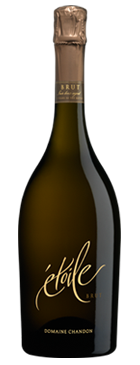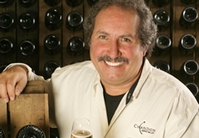For no particularly good reason, I hadn’t tasted Étoile, a non-vintage Brut and one of Chandon’s top-of-the-line cuvées, for some time until just last month. I was bowled over by the quality to price ratio. At a suggested retail price of $38, it has to be one of the best bargains in the sparkling wine category.
the sparkling wine category.
Founded almost 40 years ago in 1973, Domaine Chandon made history as the first subsidiary of a Champagne house (Moët et Chandon) in the United States. They have been innovators ever since, championing the use of small containers for harvesting to minimize damage to the grapes and introducing Pinot Meunier, the third allowed grape in Champagne (with Chardonnay and Pinot Noir) into the blend. Long before Thomas Keller and his Michelin-starred French Laundry brought culinary acclaim to the region, Domaine Chandon brought up-scale, world-class dining to the Napa Valley when it opened its restaurant (now also called Étoile) in 1977.
Étoile (the wine) is a seamless blend of Chardonnay (48%), Pinot Noir (46%) and Pinot Meunier that’s been aged on the lees (dead yeast) for a minimum of five years. The grapes come from Napa and Sonoma Counties. When pressed as to exactly where they get their grapes, winemaker Tom Tiburzi, replied, “Wherever there’s fog” to emphasize their reliance on cool areas that provide less ripe fruit.
Chandon hired Tiburzi, a trained microbiologist, in 1989 to oversee experimental winemaking trials that they were undertaking after the phylloxera epidemic forced them to replant. To determine the best viticultural practices before they replanted, Chandon embarked on an in-depth program to study the effects of vine spacing, clonal selection, choice of rootstock, canopy management, cover crops, and irrigation, among other things. They needed someone who could do “technical or scientific” winemaking, as Tiburzi described it. Some one who could ferment and age each batch the same so the differences in taste would reflect the viticulture, not the winemaking.
Tiburzi felt right at home. The laboratory setting was familiar. Even the equipment–the spectrophotometer–was the same. He noted, “It was just another [microbiologic] culture of yeast and bacteria.”
Since 2005, Tiburzi’s been the winemaker for all of Chandon’s sparkling  wines. The wines now reflect his astute winemaking skills as well as the best viticultural practices gleaned from his technical trials. Richard Geoffroy, the winemaker for Dom Perignon, Moët’s top of the line Champagne, assists Tiburzi with the final blends. They include a small portion of “reserve wines,” exceptional wines that have been held back from previous vintages, to add a touch of power and richness.
wines. The wines now reflect his astute winemaking skills as well as the best viticultural practices gleaned from his technical trials. Richard Geoffroy, the winemaker for Dom Perignon, Moët’s top of the line Champagne, assists Tiburzi with the final blends. They include a small portion of “reserve wines,” exceptional wines that have been held back from previous vintages, to add a touch of power and richness.
Not a powerhouse or overtly fruity, Chandon’s non-vintage Étoile Brut wows you with its elegance and persistence. It has plenty of concentration, but, paradoxically, it doesn’t seem powerful. The creamy flavors float across the palate.
Chandon also makes an equally engaging non-vintage Étoile Brut Rosé. Strawberry-tinged flavors provide slightly more power and fruitiness, while the gorgeous pink hue is a delight for the eyes.
These are two stellar wines.
2
